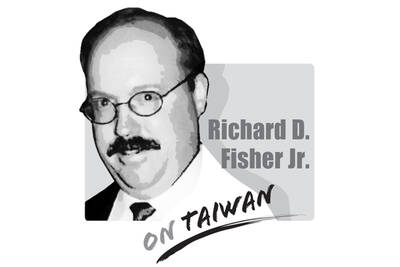Taiwan People’s Party (TPP) Acting Chairman Huang Kuo-chang (黃國昌) has formally announced his intention to stand for permanent party chairman. He has decided that he is the right person to steer the fledgling third force in Taiwan’s politics through the challenges it would certainly face in the post-Ko Wen-je (柯文哲) era, rather than serve in a caretaker role while the party finds a more suitable candidate.
Huang is sure to secure the position. He is almost certainly not the right man for the job.
Ko not only founded the party, he forged it into a one-man political force, with himself as the messianic head served by a rag-tag collection of legislators and supported by a band of young disciples. Huang is still obsessed with clearing Ko’s name in the corruption case, even if it means jeopardizing the constitutional order by casting aspersions about the independence of the judiciary. The truth is, he has to: Without Ko, the TPP could easily wither away.
Huang is weighed down by the baggage of betrayal and failure. One of the leading figures in the 2014 Sunflower movement pushing back against the Chinese Nationalist Party’s (KMT) attempts to force the controversial cross-strait service trade agreement through the legislature, he is now engaged in exactly the same behavior he once accused the KMT of. He is also doing so in the service of the KMT, with whom the TPP collectively have a legislative majority.
He joined the TPP in 2023, abandoning the foundering New Power Party, which he had cofounded and served as party chairman. This was at a time when Ko and the TPP were discussing reopening talks on a cross-strait service trade agreement. In one fell swoop, Huang turned his back on the party he founded and the movement he spearheaded.
Now in the legislature, he is selling out Ko’s original vision of the TPP as a serious alternative to the KMT/Democratic Progressive Party (DPP) dichotomy by attaching himself to the agenda of chaos orchestrated by KMT legislative caucus whip Fu Kun-chi(傅崐萁).
Under Huang, the TPP is so closely aligned with the KMT that it is difficult to distinguish it as a third force: It plays second fiddle to the main opposition party.
During Ko’s detention, Huang has seemed to be the perfect loyal lieutenant, arguing for Ko’s innocence. As acting chairman, rather than contain the damage to the party, Huang chose to up the ante, accusing the judiciary of acting on President William Lai’s (賴清德) behalf and inciting Ko’s supporters to engage in illegal assembly, preferring hyperbolic accusations of “political persecution” to rational legal arguments in Ko’s defense.
He is suited to being a stand-in, or a second-in-command, but he is no leader. His judgement has been blinded by his obsessive hatred for the DPP.
Ko, too, had developed an enmity for the DPP, but he has other things going for him. Where Ko is a charismatic maverick, Huang is gaining a reputation as a pent-up, petulant ranter. Where Ko cultivated a national-level profile — not least because of his two terms as mayor of the nation’s capital — Huang has accumulated a reputation for serial political failure and betrayal. While his face is known in the north, he is relatively unknown in central and southern Taiwan.
His obsession with the DPP and his slavish following of the KMT’s agenda, in the absence of any of Ko’s charms, raises questions about why Ko’s young supporters would vote for the TPP of Huang Kuo-chang, or why KMT supporters would once again view the TPP as a viable alternative.

On Sept. 3 in Tiananmen Square, the Chinese Communist Party (CCP) and the People’s Liberation Army (PLA) rolled out a parade of new weapons in PLA service that threaten Taiwan — some of that Taiwan is addressing with added and new military investments and some of which it cannot, having to rely on the initiative of allies like the United States. The CCP’s goal of replacing US leadership on the global stage was advanced by the military parade, but also by China hosting in Tianjin an August 31-Sept. 1 summit of the Shanghai Cooperation Organization (SCO), which since 2001 has specialized
In an article published by the Harvard Kennedy School, renowned historian of modern China Rana Mitter used a structured question-and-answer format to deepen the understanding of the relationship between Taiwan and China. Mitter highlights the differences between the repressive and authoritarian People’s Republic of China and the vibrant democracy that exists in Taiwan, saying that Taiwan and China “have had an interconnected relationship that has been both close and contentious at times.” However, his description of the history — before and after 1945 — contains significant flaws. First, he writes that “Taiwan was always broadly regarded by the imperial dynasties of
The Chinese Communist Party (CCP) will stop at nothing to weaken Taiwan’s sovereignty, going as far as to create complete falsehoods. That the People’s Republic of China (PRC) has never ruled Taiwan is an objective fact. To refute this, Beijing has tried to assert “jurisdiction” over Taiwan, pointing to its military exercises around the nation as “proof.” That is an outright lie: If the PRC had jurisdiction over Taiwan, it could simply have issued decrees. Instead, it needs to perform a show of force around the nation to demonstrate its fantasy. Its actions prove the exact opposite of its assertions. A
A large part of the discourse about Taiwan as a sovereign, independent nation has centered on conventions of international law and international agreements between outside powers — such as between the US, UK, Russia, the Republic of China (ROC) and Japan at the end of World War II, and between the US and the People’s Republic of China (PRC) since recognition of the PRC as the sole representative of China at the UN. Internationally, the narrative on the PRC and Taiwan has changed considerably since the days of the first term of former president Chen Shui-bian (陳水扁) of the Democratic